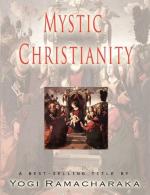And so when the Magi instituted their search they were in due time informed of this strange occurrence. And they visited the house of Joseph and Mary and saw the Babe. Making close inquiry of the parents, they found that the time of the child’s birth tallied precisely with the moment of the astrological signs. Then they cast the Child’s horoscope and they knew that their shepherd’s vision coincided with their own science, and that here indeed was He for whom the Eastern Occultists and Mystics had waited for centuries. They had found the Master! The Star Child was before them!
Then these Great Men of their own lands—these Adepts, Masters and Hierophants—prostrated themselves on the ground before the child and gave him the salutation due only to the great Occult Master of Masters who was come to take his seat upon the Throne of the Grand Master of the Great Lodge. But the child knew naught of this, and merely smiled sweetly at these strange men in gorgeous foreign robes, and reached out his little hand toward them. But Occult tradition has it that the tiny fingers and thumb of his right hand, outstretched toward the Magi, unconsciously assumed the mystic symbol of the Occult Benediction, used by the Masters and Hierophants (and now used by the Pope in Papal Benediction) and gave to the worshippers that Master’s benediction. The tiny Master of Masters thus gave his first blessing to his followers, and exalted worshippers. But His Throne was not that of the Great Lodge, but a still higher place—the knees of a Mother!
And the Magi then made mystic and symbolic offerings to the child—Gold, Frankincense and Myrrh offered they Him. Gold, signifying the tribute offered to a Ruler, was the first symbol. Then came Frankincense, the purest and rarest incense used by the Occult and Mystic Brotherhoods and Orders, in their ceremonies and rites, when they were contemplating the sacred symbol of the Absolute Master of the Universe—this Frankincense was their symbol of worship. Then, last symbol of all, was the Myrrh, which in the occult and mystic symbolism indicated the bitterness of mortal life, bitter though pungent, preserving though stinging—this was the meaning of the Myrrh, that this child, though Divine in his inner nature, was still mortal in body and brain, and must accept and experience the bitter tang of life. Myrrh, the strength of which preserves, and prevents decay, and yet which smarts, and tangs, and stings ever and ever—a worthy symbol of Mortal Life, surely. Wise Men, indeed, ye Magi! Gold, Frankincense, and Myrrh—a prophecy, symbol, and revelation of the Life of the Son of Man, with His indwelling Pure Spirit.
And the Magi, having performed their rites and ceremonies, departed from Bethlehem. But they did not forget the Child—they preserved a careful watch over his movements, until they saw him again. Saw Him again? you ask? Yes, saw him again! Though the Gospels say naught of this, and are silent for a period of many years in the Life of Jesus, yet the records and traditions of the Mystics of the East are filled with this esoteric knowledge of these missing years, as we shall see as we proceed. Left behind by the Magi, but still under their loving care, the Child waxed strong and grew in mind and body.




